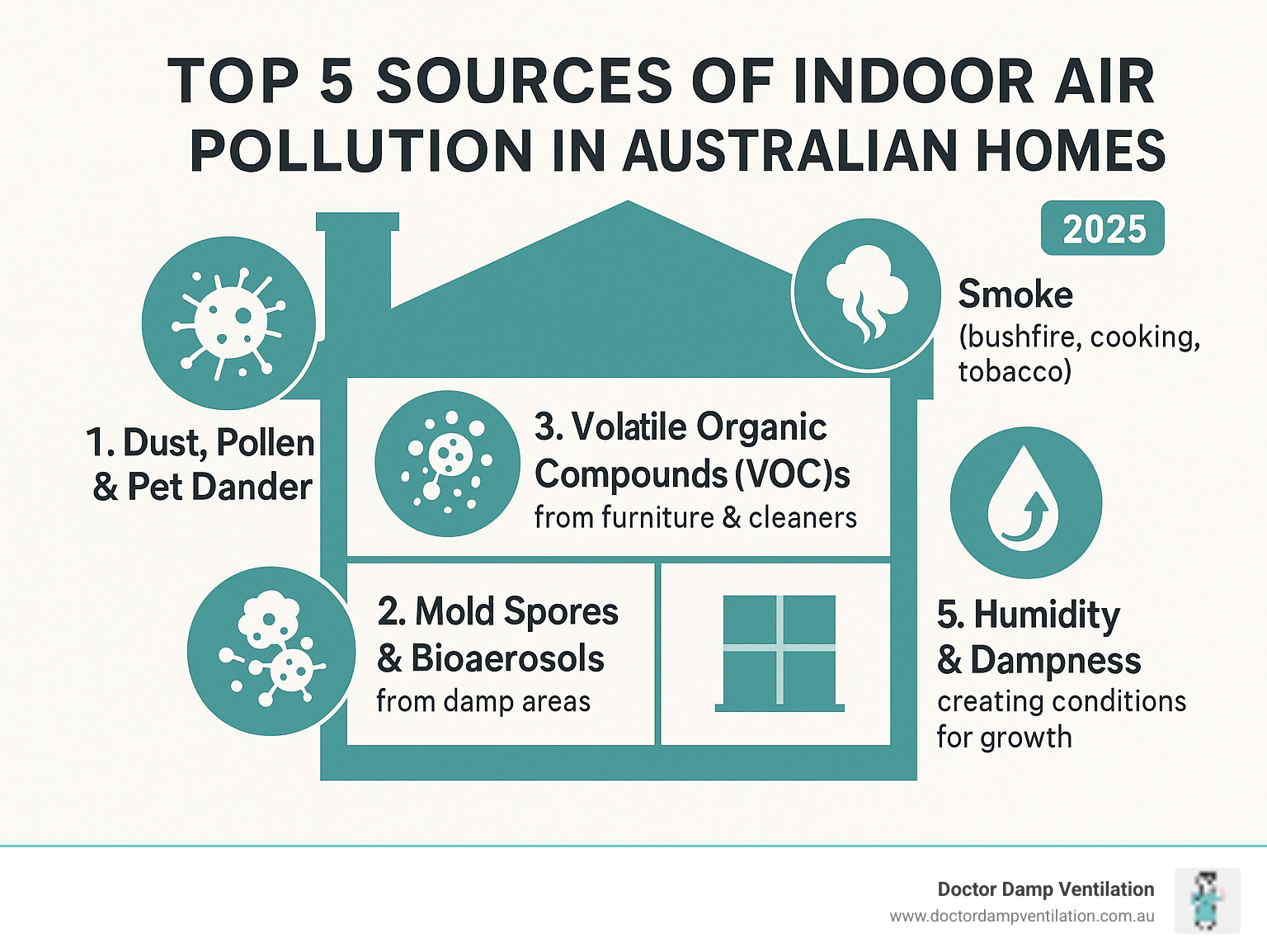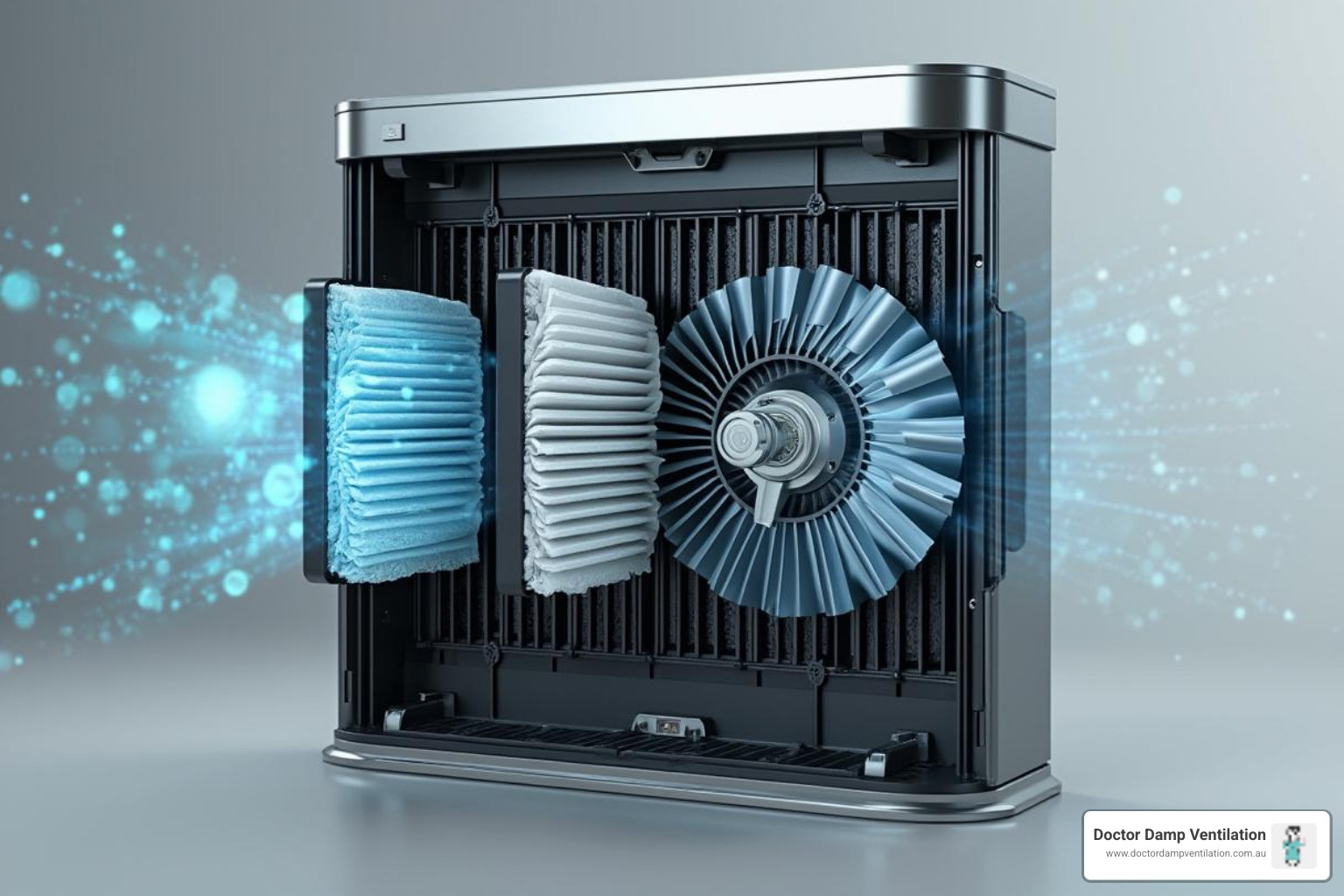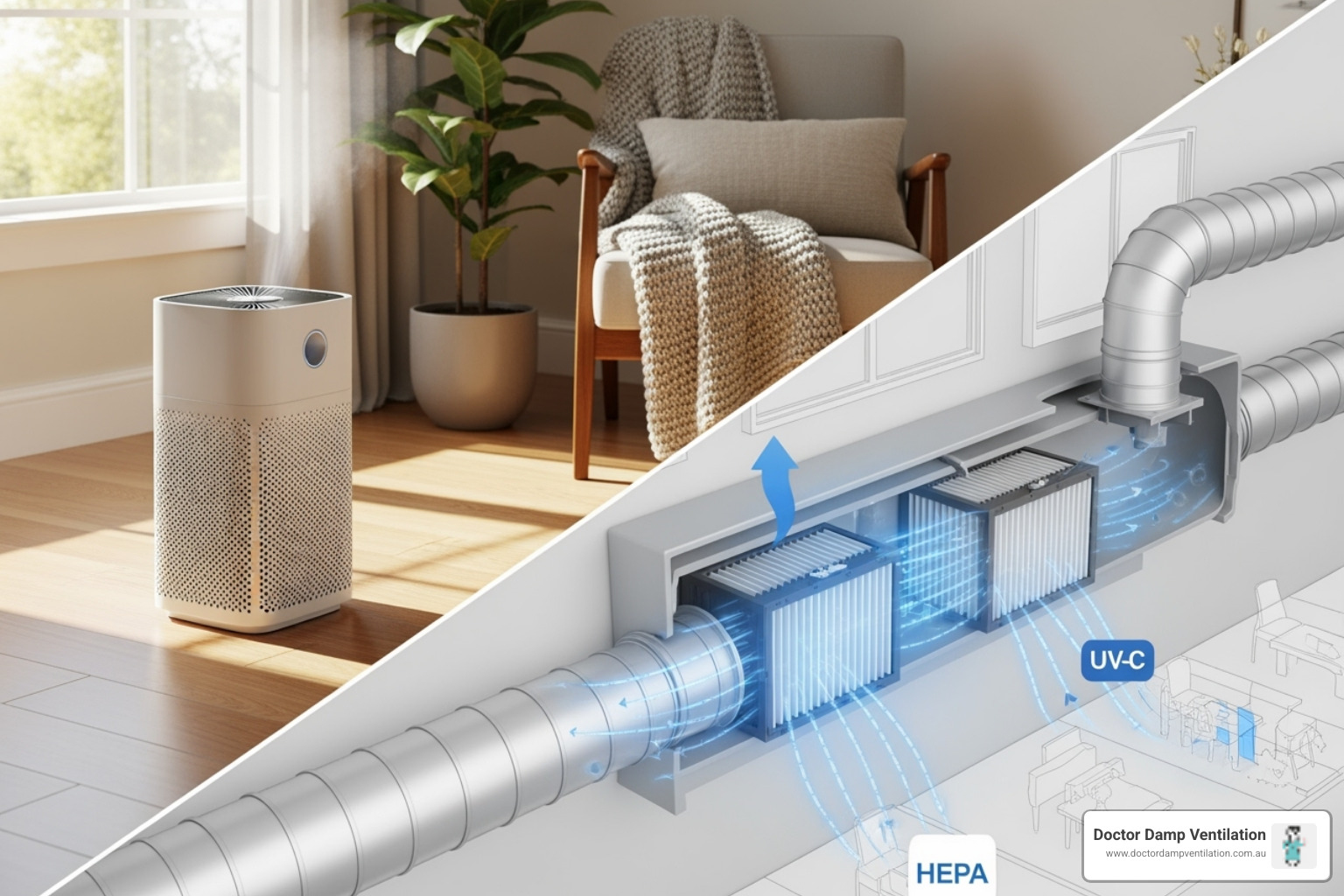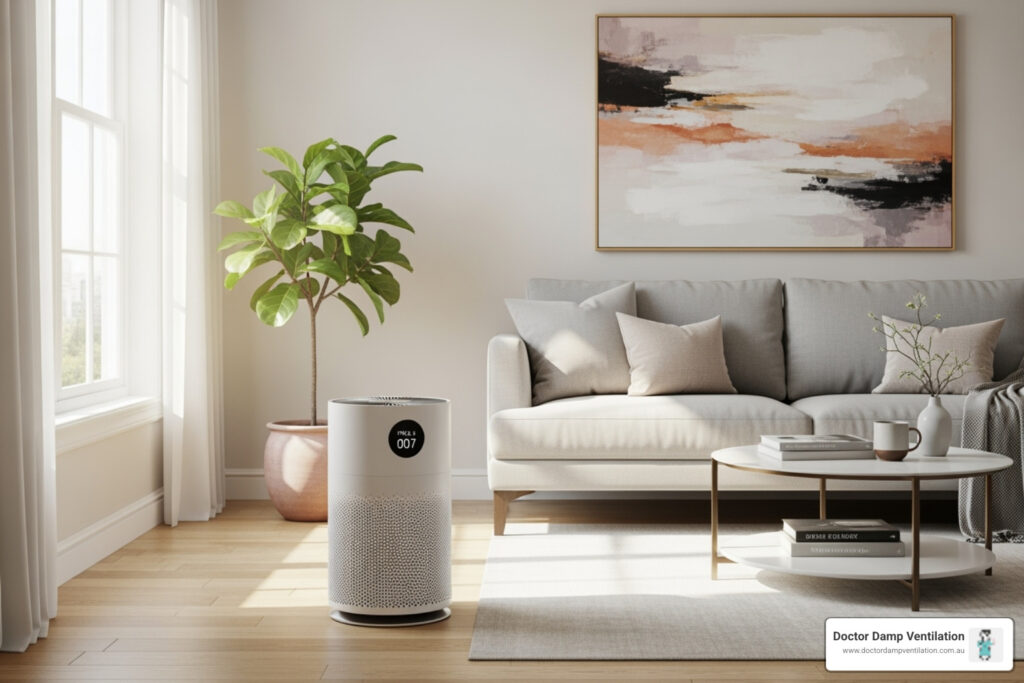Home Air Purification: Scam or Truth 2025?
Why Your Home’s Air Might Be Dirtier Than You Think
#
When it comes to home air purification, many wonder if these devices are truly effective. The short answer is yes. Air purifiers can:
- Remove airborne particles: Dust, pollen, pet dander, and smoke. HEPA filters capture 99.97% of particles at 0.3 micrometers.
- Reduce mold and germs: Certain technologies target bioaerosols common in damp homes.
- Combat odors and VOCs: Activated carbon filters are effective against smells and chemical vapors.
- Improve indoor air quality: The EPA states indoor air can be two to five times more polluted than outdoor air.
- Support a healthier home: Especially for those in Sydney with allergies or respiratory issues.
With so many claims, it’s fair to question if home air purification is a solution or just an expensive gadget. The truth is, the air inside our homes is often much dirtier than the air outside, trapping invisible threats like dust, pollen, pet dander, mould spores, and chemical vapors (VOCs). These can contribute to allergies, asthma, and general fatigue.
I’m Scott Lambert, founder of Dr. Damp and Australia’s leading expert in residential moisture control. With over 20 years of experience, I’ve seen how crucial effective home air purification is for a healthy living environment.

We seal our homes for energy efficiency, but this traps a cocktail of airborne nasties. Common culprits include:
- Dust mites & Pet dander: Major sources of allergens in carpets and bedding.
- Pollen: Microscopic grains from trees and grasses that sneak indoors, a big issue during allergy season in Sydney.
- Airborne mold & bacteria: Mould spores are a significant concern in humid climates or damp homes.
- Volatile Organic Compounds (VOCs): Gases emitted from paints, cleaning supplies, furniture, and building materials.
Breathing this invisible soup can cause allergies (sneezing, watery eyes), trigger asthma attacks, and lead to other respiratory issues. In Sydney, particularly in areas like Bondi or inner-west suburbs like Newtown, dampness and mould are major challenges, significantly impacting indoor air quality.
The Hidden Dangers of Mould and Damp
Mould isn’t just an eyesore; it’s a living organism that thrives on moisture. Whether it’s a musty odour in a Paddington wardrobe or black spots on a ceiling in Manly, mould is a clear sign of excess moisture. It releases microscopic spores into the air, which can cause allergic reactions, respiratory diseases, and other serious health issues from mycotoxins. Beyond health, mould causes structural damage, deteriorating plasterboard and timber.
The link between dampness and poor air quality is undeniable. Without addressing the underlying moisture problem, home air purification is only a temporary fix. At Doctor Damp Ventilation, we specialise in getting to the root of the problem. You can find More info about our Mould Removal services.
Pollutants Targeted by Home Air Purification
Air purifiers with HEPA filters excel at removing particulate matter like dust, pollen, pet dander, mould spores, and smoke particles—a common concern for homes in Penrith or Campbelltown during fire season. Technologies like UV-C can destroy airborne viruses and bacteria, while activated carbon filters are effective at adsorbing VOCs and odours from cooking, pets, and smoke. However, purifiers primarily address airborne pollutants, not those embedded in surfaces like mould on a wall.
Decoding Air Purification Technologies: What Really Works?
Facing rows of air purifiers can be confusing. HEPA, UV-C, ionizers—what does it all mean? At its core, home air purification works in two ways: filtration (trapping pollutants) and sanitization (destroying them). The most effective purifiers combine both.

Think of it as a multi-layered security system for your air, with different technologies tackling different pollutants.
Mechanical & Carbon Filters: The Gold Standard
Mechanical and activated carbon filters are the tried-and-true champions of home air purification. They are reliable, consistent, and safe.
HEPA filters (High-Efficiency Particulate Air) are the heavy lifters, capturing 99.97% of airborne particles as small as 0.3 micrometers. This includes dust, pollen, pet dander, mould spores, and smoke particles from bushfires that can affect Sydney’s western suburbs like Penrith. Be wary of terms like “HEPA-type” or “HEPA-like” on cheaper units, as they don’t meet this strict standard.
Activated carbon filters tackle gases and odours through a process called adsorption. Millions of tiny pores trap gas molecules and odour compounds from cooking, pets, or chemical vapors. While effective for many smells, they struggle with gases like formaldehyde or ammonia.
The main benefit of these filters is their reliability and safety. They produce no harmful byproducts and are safe for continuous use. The downside is the ongoing cost of replacement. HEPA filters typically last 6-12 months, while carbon filters may need changing every 3 months.
| Filter Type | Pollutants Captured | Maintenance | Cost (Filter Replacement) |
|---|---|---|---|
| Pre-filter | Larger particles (dust, pet hair) | Washable or vacuumable, extends other filter life | Low (often reusable) |
| HEPA Filter | 99.97% of particles ≥ 0.3 microns (dust, pollen, dander, mould spores, smoke) | Replace every 6-12 months (varies by usage) | Moderate to High |
| Activated Carbon | Gases, VOCs, odours | Replace every 3 months (can be more frequent for heavy odours) | Moderate |
UV-C, PCO, and Ionizers: The Sanitizers
Beyond filtration, some purifiers actively destroy pollutants. These sanitizing technologies can be effective but come with important caveats.
UV-C Germicidal Irradiation uses ultraviolet light to sterilize viruses, bacteria, and mould spores. It’s a technology recommended by the CDC and ASHRAE alongside HEPA filtration. However, its effectiveness in consumer units depends on sufficient UV lamp power and exposure time, which some models lack.
Photocatalytic Oxidation (PCO) uses UV light and a catalyst to break down VOCs and odours. While clever, some PCO systems can produce harmful byproducts like ozone and formaldehyde. One laboratory study on PCO showed mixed results, highlighting inconsistencies in performance.
Negative ion generators release charged particles that cause pollutants to stick to surfaces. The major red flag is that many of these systems produce ozone, a lung irritant that can worsen asthma. Low levels of ozone are not effective at destroying pollutants and can harm your health.
The bottom line: sanitizing technologies can be a useful addition to mechanical filtration, but never rely on them alone. Always choose systems certified to produce zero ozone. For Sydney homeowners in suburbs like Bondi, these technologies can help with airborne contaminants but won’t solve the underlying moisture problems that cause mould growth.
How to Choose the Right Air Purifier for Your Home
Choosing the right home air purification unit is simpler when you focus on a few key factors. Whether you’re in a Surry Hills apartment or a family home in Blacktown, understanding room size, cleaning speed, noise, and filter costs will help you make a smart choice.

Understanding Key Performance Metrics
Knowing a few key terms makes choosing a purifier much easier.
Clean Air Delivery Rate (CADR) measures how quickly a purifier removes smoke, pollen, and dust. A higher CADR means faster cleaning. Look for the AHAM Verifide seal, which indicates independently verified ratings.
Air Changes per Hour (ACH) tells you how many times the purifier filters all the air in a room in one hour. Aim for 2-3 ACH for general use, or 4-5 ACH if someone in your home has allergies or asthma.
It’s crucial to match the purifier to your room size. A small unit won’t be effective in a large Penrith living room, and a powerful unit is overkill for a small Paddington bedroom. When in doubt, choose the slightly larger model and run it on a lower, quieter setting.
Noise levels, measured in decibels (dB), are important, especially for bedrooms. Look for models that operate below 50 dB on low settings, which is about as loud as a quiet refrigerator.
Energy efficiency is also key, as your purifier will likely run continuously. Look for Energy Star certified purifiers to save on electricity bills and reduce your environmental impact.
The True Cost of Home Air Purification
Budgeting for home air purification involves more than the initial purchase price. The true cost includes several factors.
- Initial Purchase Price: This can range from under $100 for basic models to over $1,000 for advanced systems.
- Filter Replacement: This is the most significant ongoing cost. HEPA filters ($20-$200+) need replacing every 6-12 months, while activated carbon filters ($20-$50+) may need changing every three months. Factoring these recurring costs into your budget is essential. Washable pre-filters can help extend the life of more expensive filters.
- Energy Consumption: A purifier running 24/7 will use electricity. Energy Star models are more efficient, but it’s still a continuous operating cost.
The long-term value, however, extends beyond money. For many, the investment is worthwhile for the health benefits and improved quality of life from breathing cleaner air.
Portable Units vs. Whole-Home Solutions
When considering home air purification, you have two main options: portable room units or whole-home systems integrated with your HVAC. The right choice depends on your home and needs, whether you’re in a cozy Paddington apartment or a large family home in Parramatta.

When to Use Portable Air Purifiers
Portable air purifiers provide targeted protection in specific rooms. They are ideal for:
- Allergy Sufferers: Placing a unit in the bedroom can create a clean-air sanctuary for sleeping, reducing exposure to triggers like pet dander.
- Home Offices: Clean air in your workspace can improve concentration and reduce fatigue.
- Renters: For those in areas like Glebe or Bondi Beach, portable units require no installation and can move with you.
- Supplemental Use: They can boost air quality in high-traffic areas or nurseries, even in homes with central systems.
The main limitation is that you’d ideally need a unit for every room, which can be impractical and costly.
The Power of Whole-Home Ventilation
Whole-home systems integrate with your HVAC to deliver clean air throughout your entire property, ensuring consistent air quality from your living room in Randwick to bedrooms in Engadine.
However, true whole-home air quality is fundamentally linked to proper ventilation and moisture control. An air purifier can’t win a battle against an underlying dampness problem.
This is why the role of ventilation in a Healthy Home is so critical. Standard air conditioning circulates air but doesn’t eliminate the root causes of dampness that breed mould.
Addressing the source is where systems like Sub Floor Ventilation are game-changers. In areas like Hurstville or Rockdale, trapped sub-floor moisture rises into living spaces, causing musty smells and mould growth that no purifier can solve alone.
Our Xchange Air systems offer a comprehensive approach by controlling condensation throughout your home, not just treating symptoms. They tackle both airborne pollutants and their sources, combining robust ventilation with purification for truly healthy indoor air.
Frequently Asked Questions about Home Air Purification
At Doctor Damp Ventilation, we get many questions about home air purification. Here are clear, straightforward answers to the most common ones.
How often do I need to change the filters?
Filter replacement frequency depends on your home’s environment and how often you run the unit. Always follow the manufacturer’s guidelines, but here’s a general rule:
- Pre-filters: These catch large particles like dust and pet hair. Many are washable and should be cleaned every few weeks to extend the life of other filters.
- HEPA filters: These workhorses capture tiny particles and typically need replacing every 6 to 12 months. In a home with pets in Bondi or near a busy Parramatta road, you may need to change them more often.
- Activated carbon filters: These tackle odours and VOCs and usually need replacement every 3 months, as they saturate more quickly.
Many modern purifiers have a filter indicator light to take the guesswork out of maintenance.
Can an air purifier get rid of mould?
This is a critical distinction: an air purifier helps with airborne mould spores but cannot remove mould growth on surfaces.
- What it does: A purifier with a HEPA filter is excellent at capturing microscopic mould spores floating in the air, reducing your exposure to these allergens.
- What it doesn’t do: It cannot kill or remove mould that is already growing on walls, ceilings, or other surfaces. Mould will continue to thrive as long as its moisture source exists.
If you see visible mould or smell a musty odour, especially in a damp bathroom in Cronulla or a sub-floor in Woollahra, an air purifier is only a band-aid. You must address the source of the moisture. An air purifier is a great supplementary tool, but it is not a substitute for professional mould remediation and damp-proofing solutions.
Where is the best place to put my air purifier?
Smart placement significantly boosts your purifier’s effectiveness.
- Choose the right room: The bedroom is often the best choice, as clean air during sleep is vital, especially for allergy sufferers. Otherwise, place it in the room where you have the most air quality concerns.
- Position for airflow: Don’t tuck the unit in a corner or behind furniture. Place it where air can circulate freely, ideally a few feet away from walls and other obstructions.
- Keep vents clear: Ensure the air intake and output vents are completely unobstructed for peak performance.
- Consider noise: If noise is a concern in a bedroom, you can run the purifier on a higher setting during the day and switch to a quieter, lower setting at night.
Conclusion: A Crucial Tool, Not a Magic Bullet
Is home air purification a scam? Absolutely not. When used correctly, air purifiers are effective tools for creating healthier indoor environments. They excel at removing airborne particles, allergens, and odours, making a real difference for Sydney residents, from those dealing with bushfire smoke in Penrith to pet owners in Bondi apartments.
However, it’s crucial to understand that home air purification is one piece of a larger puzzle. Air purifiers filter what’s in the air, but they can’t eliminate the source of problems like dampness, mould growth, and poor ventilation.
This is where Doctor Damp Ventilation’s expertise is invaluable. A truly healthy home requires a comprehensive approach:
- Source Control: Eliminating the cause of pollution, like a leak causing mould in a Randwick bathroom.
- Proper Ventilation: Ensuring adequate airflow with systems like Sub Floor Ventilation to prevent moisture build-up, a common issue in areas like Hurstville.
- Air Purification: Using a purifier as the final layer of protection to capture any remaining airborne irritants.
This holistic strategy—combining source control, ventilation, and purification—is the difference between masking problems and solving them for good.
Your First Step to Truly Clean Air
Here are three key takeaways:
- Air purifiers work for airborne pollutants. Invest in a unit with genuine HEPA and activated carbon filters, sized correctly for your space.
- Avoid ozone-producing technologies. Always verify zero-ozone certification.
- Purifiers can’t fix dampness or mould at the source. They address symptoms, not the underlying cause.
If you’re experiencing mould, dampness, or musty odours, an air purifier will help with the immediate air quality. But for a lasting solution that protects your health and property, you must address the source.
That’s what we do best. Contact us for a comprehensive mould and damp assessment and let us help you create a truly healthy home environment.

